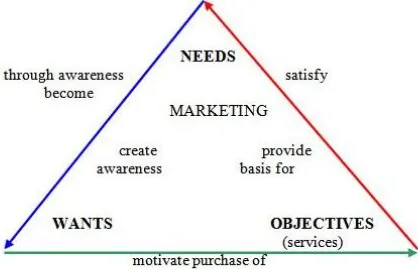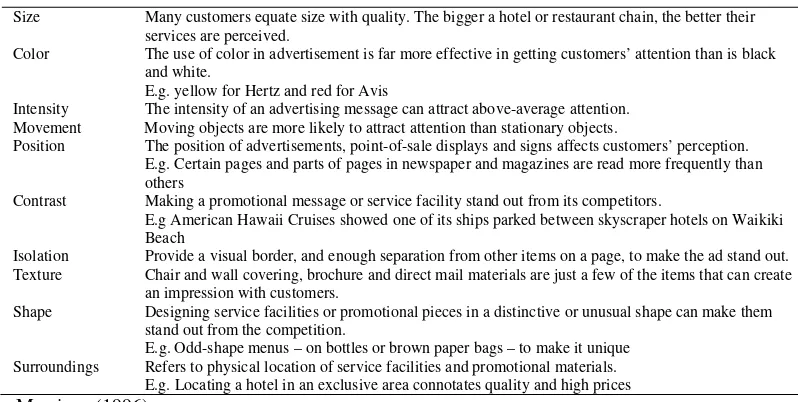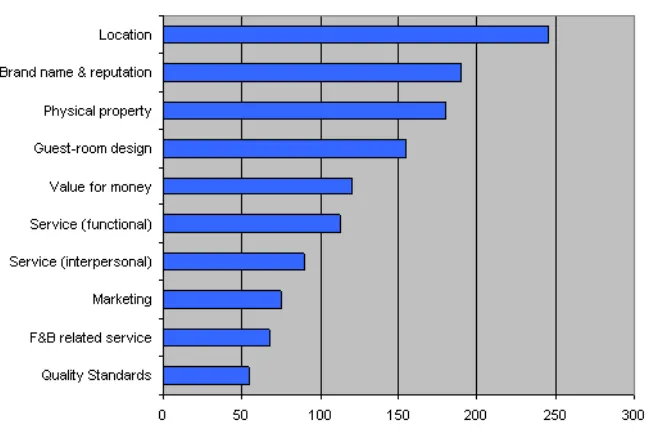HOW CUSTOMERS CHOOSE HOTELS
Hera Oktadiana
1; Andhika Kurnia
2Jurusan Hotel Manajemen, Fakultas Ekonomi dan Bisnis, Bina Nusantara University Jln. K.H. Syahdan No. 9, Kemanggisan, Palmerah, Jakarta Barat 11480
ABSTRACT
In the advancement of hospitality industry, thus it is important for hotel sales and marketing to understand the customer behavior in order to create effective marketing. Factors that influence customer behavior as individuality consist of personal and interpersonal factors. Personal factors include the needs, wants, motivation, perception, learning, personality, lifestyle, and self-concept. Meanwhile, interpersonal factors come from culture and sub-culture, group references, customers through stages before deciding to purchase. Begin with the awareness about the needs, customers then find information about the product or service that could be used to solve the problems. After having the information, customers select the best product and service before deciding to purchase. After purchasing, the last stage is evaluation of product and service, whether it is satisfying or not.
Keywords: customer behavior, customers’ buying decision
ABSTRAK
Dengan semakin pesatnya perkembangan industri hospitality, maka semakin penting bagi seorang tenaga penjualan dan pemasaran hotel untuk memahami mengenai perilaku konsumen, agar dapat tercipta pemasaran yang efektif. Faktor-faktor yang mempengaruhi perilaku konsumen sebagai individual terdiri atas factor personal dan factor interpersonal. Faktor personal mencakup kebutuhan, keinginan dan motivasi, persepsi, pembelajaran, personality, gaya hidup dan konsep diri. Sedangkan faktor interpersonal berasal dari budaya dan sub-budaya, referensi kelompok, kelas sosial, opini pemimpin dan keluarga. Saat melakukan suatu pembelian, konsumen melalui beberapa tahapan sebelum akhirnya memutuskan untuk membeli. Diawali dengan kesadaran adanya suatu kebutuhan, konsumen kemudian akan mencari informasi tentang produk atau jasa yang dapat digunakan untuk memecahkan kebutuhannya. Setelah menggali dan mendapatkan informasi, maka konsumen akan melakukan seleksi terhadap produk atau jasa yang terbaik, sebelum akhirnya memutuskan untuk membeli. Setelah membeli, maka tahap terakhir adalah evaluasi terhadap produk atau jasa yang telah dibeli, apakah memuaskan atau tidak.
INTRODUCTION
As the lodging industry becomes more and more competitive, there is an increased need to understand the customer. Many sales people have a good understanding of what they are selling, but less understanding of how customers evaluate what is being offered. All customers got through a series of steps when they decide to buy a hospitality or travel service, therefore, marketers need to understand customers behavior and the decision process that customers are using.
Behavior of Individual Customers
According to Morrison (1996), customer behavior is the ways in which customers select, use and behave after they have purchased hospitality and travel services. There two types of factors influence the behavior of individual customers: personal and interpersonal. Personal factors are the psychological characteristics of the individual, whereas interpersonal factors represent the outside influence of other people. Personal and interpersonal influences are at play at the same time.
Table 1 Personal and interpersonal factors
Personal Factors Interpersonal Factors
1. Needs, wants and motivation 2. Perception
3. Learning 4. Personality 5. Lifestyle 6. Self-concept
1. Cultures and subcultures 2. Reference groups 3. Social classes 4. Opinion leaders 5. The family
Personal Factors
Needs, Wants and Motivation
Customer needs are the base of marketing and satisfying them is the key to long-term success. If there is a gap between what customers have and what they would like to have, then a need will exist. For example, flying business class and staying in the most expensive resort hotel may be based on a need for esteem. Wants are the customers’ desire for specific satisfiers of their needs. For each need, there can be several wants. In order to satisfy the wants, customers need to be motivated. Motives are customers’ personal desires or drives to satisfy their wants. Marketers have to suggest motives to customers involving the use of objectives (Morrison, 1996).
One of the popular motivational theories is Maslow’s hierarchy of needs. Below are the samples of Maslow’s needs, the motives and wordings that can be used for advertisement.
Table 2 Maslow’s Needs and the Wording in the Advertisement
Need Motive Wording in Advertisement
Physiological Relaxation Four seasons hotels/resorts:
Introducing Four Seasons Resorts, the perfect environment for relaxing everything but your expectations
Safety Security American Express:
There’s one Travelers Cheque for couples who have tied the knot, just not around each other
Belonging Love Princess Cruises:
It’s more than a cruise, it’s the boat love Esteem Achievement status The province of Beverly Hills
Self-actualization Be true to one’s own nature
Outward Bound:
Our courses are limited to 12 students, but our classrooms are quite large
Personal Factors
Perception
Kotler, Bowen & Maken (2006) stated that perception is the process by which individual selects, organizes and interprets information to create a meaningful picture of the world. People can have different perceptions in the same situations because people as an individual, experiences a stimulus through our five senses: sight, hearing, taste, touch and smell. When a customer visit a hotel that has a swimming pool, business center, banquet services, fitness and spa facilities, shopping arcades, coffee shop, lounge and fine-dining restaurant, the customer will perceive that the hotel is a luxury-typed hotel. When visiting a hotel that only provides rooms and a coffee shop, a customer will perceive that it is a limited hotel.
Size, color, intensity, movement, position, contrast, isolation, texture, shape, and surroundings are factors that can also be used to get through customers’ perceptual screens.
Table 3 Perceptions in customers’ perceptual screen
Size Many customers equate size with quality. The bigger a hotel or restaurant chain, the better their services are perceived.
Color The use of color in advertisement is far more effective in getting customers’ attention than is black and white.
E.g. yellow for Hertz and red for Avis
Intensity The intensity of an advertising message can attract above-average attention. Movement Moving objects are more likely to attract attention than stationary objects.
Position The position of advertisements, point-of-sale displays and signs affects customers’ perception. E.g. Certain pages and parts of pages in newspaper and magazines are read more frequently than others
Contrast Making a promotional message or service facility stand out from its competitors.
E.g American Hawaii Cruises showed one of its ships parked between skyscraper hotels on Waikiki Beach
Isolation Provide a visual border, and enough separation from other items on a page, to make the ad stand out. Texture Chair and wall covering, brochure and direct mail materials are just a few of the items that can create
an impression with customers.
Shape Designing service facilities or promotional pieces in a distinctive or unusual shape can make them stand out from the competition.
E.g. Odd-shape menus – on bottles or brown paper bags – to make it unique Surroundings Refers to physical location of service facilities and promotional materials.
E.g. Locating a hotel in an exclusive area connotates quality and high prices
Learning
Buying hospitality service has to be learned through experience. Learning comes through a combination of factors—needs, motives, objectives, cues, responses and reinforcement (Morrison, 1996). When a customer stays in a resort hotel and he or she has a great time there, the customer forms a positive experience from his or her experience.
Personality
Personality is all the qualities that make up a person’s character, that is all the things that make a person unique (motivation, perception, learning and emotion) and the different ways that every person thinks and acts. The types of personality include outgoing, self-confident, quiet, flexible, defensive, and many others.
Lifestyle
Lifestyles are the way we live; how a person spends his time and money. It is expressed in a person’s activities, interests and opinions.
Self-Concept
People tend to behave according to their self-concept or self-image. That is why people buy things that they perceive as matching the images of themselves.
Interpersonal Factors
Cultures and subcultures
Morrison (1996) stated that a culture is an amalgamation of the beliefs, values, attitudes, habits, traditions, customs and forms of behavior that are shared by a group of people. Culture is learned, not inherited. We learn our culture from our parents and our community. Culture affects our decisions about buying hospitality services. E.g. Japanese tend to travel in groups, whereas Americans prefer to travel on their own. Latin American put family as priority, and they like to have opinions from their family before making a purchase decision.
Reference Group
Many people buy products or services based on the references from the family, friends, or working colleagues. Family and friends are the primary groups. Secondary groups include those at work or clubs. The purchase of hospitality services can be affected by these reference groups.
Social Classes
Social class is determined by occupation, income, level of education, place of residence and family history. These classes demonstrate distinct product and brand preferences for clothing, automobiles, housing, and leisure activities. They have different media preferences and ways in which individuals communicate with one another.
Opinion Leaders
The Family
Family is among the strongest interpersonal influences on consumer behavior. Purchasing behavior varies with life-cycle stages. Murphy and Staples have identified nine life-cycle stages: Bachelor, Newly married (young, no children), Full nest I (youngest child under age 6), Full nest II (youngest age 6 or older), Full nest III (older married couples with dependent children), Empty nest I (household head working), Empty nest II (household head retired), Solitary survivor (working) and Solitary survivor (retired).
How Customers Make Choices
Understanding the customer’s buying decision process is most important to marketers. These are five stages that a customer goes through before and after making a purchase. Customers, however, do not always follow each of the stages. In each of the stages, there are important elements that hotel managers and marketers should consider.
Figure 2 Customer’s buying decision process Source: Morrison (1996)
Need Awareness/Arousal
A need deficiency must be recognized; a traveler needs a hotel room when visiting a city or a family wants to take a vacation. When a traveler says they need a place to stay, what are they really saying? Do they actually need a place to sleep, or security, or comfort? Hotel managers and marketers must try to identify the real reasons why people stay in hotels and cater to those wants and needs.
Search for Alternatives
Customer normally begins an information search when a “want” exists. Generally, the search and evaluation process would be short and uncomplicated if the purchase is relatively inexpensive, unimportant, common, and relatively easy to understand and use. On the other hand, the search and evaluation process would be extensive and complex if the purchase is relatively expensive, relatively important, relatively uncommon, or relatively difficult to understand and use.
When searching for a budget motel for an overnight stay, the purchase will be relatively inexpensive, probably not too personally important, and fairly common in occurrence. This person would not likely spend a lot of effort in searching for or evaluating alternative budget motels. When this person is looking for a vacation resort such as in Maldive, then the situation will change. Now the purchase will be rather expensive. Now this person will spend a lot more time reading brochures, talking to friends, and speaking to travel professionals before making a final decision.
Evaluation of Alternatives/Purchase
Every choice alternative has a series of attributes or characteristics that customers will consider when choosing a particular alternative. For example, Hotel A might have the following attributes: low price, good location, no swimming pool. Similarly, Hotel B might have the following attributes: high price, suburban location, a swimming pool. A customer is going to have to make a decision as to which hotel to patronize. But how? First, there is some assessment made as to the desirability of a certain attribute that the hotel may possess. Second, there is some strength of belief as to whether the hotel being evaluated actually possesses that attribute. These two components would be combined to provide the customer with an overall evaluation for each hotel being assessed. An algebraic representation of this process is as follow:
WhereAo = the overall attitude toward the alternative hotel e¡ = desirability of attribute i
b¡ = the strength of belief that the alternative hotel possesses attribute i n = the number of different attributes being evaluated
For each attribute being considered, the desirability value and the belief strength value are multiplied, and then totaled for all the attributes considered. These mathematical totals are then compared, and the hotel with the most positive final total is the hotel the consumer would choose. Now assume that the following situation occurs. A traveler is looking for a hotel, and finds Hotel A and Hotel B. How is a choice between the two hotels made? For Hotel A the traveler believes that low price and good location are very positive considerations, but the absence of a swimming pool is also quite negative. For Hotel B the traveler thinks high prices and mediocre location are somewhat negative attributes, but a swimming pool is quite positive. Thus the desirability levels for both hotels’ attributes, based on a scale of +5 for very positive to –5 for very negative, might appear as follows:
Table 4 Customer’s desirability levels
Hotel A Hotel B
Price +5 -3
Location +5 -3
Swimming pool - 4 +4
The traveler is somewhat sure that Hotel A has low prices, a good location and a swimming pool. Alternatively, the traveler is not sure that Hotel B is expensive and has a so-so location, but is positive there is a swimming pool. Thus the belief strengths (weight) concerning the presence of the attributes, based on a scale of +10 for being positive—the hotel has the attribute, to 0 for being positive—the hotel does not have the attribute, might appear as follows:
Table 5 Customer’s desirability levels
Hotel A Hotel B
Price +6 +4
Location +7 +5
Swimming pool +6 +10
n
Using the formula given above, the results would be as follows:
Overall evaluation Hotel A (+5)(+6) + (+5)(+7) + (-4)(+6) = 41
Overall evaluation Hotel B (-3)(+4) + (-3)(+5) + (+4)(+10) = 13
In this case, the traveler would pick Hotel A because the overall evaluation (41) is higher then the overall evaluation of Hotel B (13).
Post-Sale Service (Usage and Reevaluation)
Once a guest purchases the use of a hotel room the evaluation of the actual stay begins. If performance is greater than expectations then the guest will be satisfied. If expectations are greater than performance then the guest will be dissatisfied. If the guest is satisfied, then some positive behaviors might result. The guest will start to become brand loyal, they usually will tell other people that the hotel is good. Negative behaviors might occur when the guest is dissatisfied. The guest probably will switch to another hotel, tell other people that the hotel is not good, write a complain letter or sue the hotel.
What Influences the Hotel-Purchase Decision?
Based on survey towards 469 frequent travelers done by Dube & Renaghan (2000), major factors influencing purchase decision of the hotel customers are identified. As can be seen on the graph below, there are 10 attributes driving customers’ purchase decisions. Customers noted location as a primary determinant of their purchases decision, then followed by brand name and reputation. The value associated with brand name and reputation was primarily derived from customers’ familiarity with the brand, customers’ perception of a positive and distinctive brand image, and from positive work-of-mouth referral from friends, family and travel agents.
The physical appearance of the hotel exterior and public spaces and the guest room’s design (size, amenities, cleanliness and comfort, room features) are the nest two attributes in frequency. The fifth attribute driving a customer’s decision to stay in a hotel comes from value for money, which mostly focused on the price side of the value equation (Value = Quality : Price). The functional and interpersonal services come in sixth and seventh. Since a hotel cannot be tried before making a purchase commitment, those important attributes have less effect on a customer’s purchase consideration. At the functional level, efficiency at check-in and check-out emerged as the hotel process most critical in driving the purchase decision. Friendliness appears to be the interpersonal dimension of service identified most frequently as a value driver at purchase.
Figure 3 Frequency
CONCLUSION
Understanding how customers behave is a prerequisite for effective marketing. Personal and interpersonal factors strongly influence customers’ choice of hospitality service. The personal factors include needs, wants, and motivation; perception; learning; personality; lifestyle; and self-concept. Interpersonal influences come from cultures and subcultures; reference groups; social classes; opinion leaders; and the family. Customers go through different steps in making a purchase decision. The actual steps followed, and the sequence of these steps, vary according to the importance/value of the purchase and the perceived degree of difference between alternatives. To be successful, marketers must understand their customers’ decision process.
REFERENCES
Dube, L., & Renaghan, L. M. (2000). Creating visible customer value. Cornell University.
Kotler, P., Bowen, J. T., & Makens, J. C. (2006). Marketing for hospitality and tourism (4th ed.). New Jersey: Prentice Hall.




